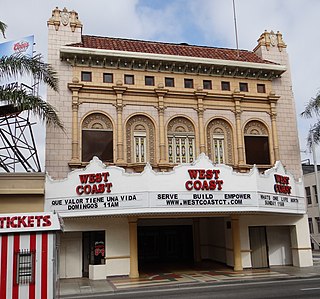
Santa Ana is a city in and the county seat of Orange County, California, United States. Located in the Greater Los Angeles region of Southern California, the city's population was 310,227 at the 2020 census, making Santa Ana the second most populous city in Orange County, the 13th-most populous city in California, and the 64th densest large city in the United States. Santa Ana is a major regional economic and cultural hub for the Orange Coast.
Landmark Theatres is a movie theatre chain founded in 1974 in the United States. It was formerly dedicated to exhibiting and marketing independent and foreign films. Landmark consists of 34 theatres with 176 screens in 24 markets. It is known for both its historic and newer, more modern theatres. Helmed by its President Kevin Holloway, Landmark Theatres is part of Cohen Media Group.

The Sunshine Building is a historic six-story building in downtown Albuquerque, New Mexico. It was built in 1924 by local theater owner Joseph Barnett and houses the Sunshine Theater as well as commercial space and offices. The Sunshine operated primarily as a movie theater until the 1980s, though it was also equipped for Vaudeville shows and other live performances. Since 1990 it has operated as a live music venue, hosting many notable acts. The building was listed on the New Mexico State Register of Cultural Properties in 1985 and is also an Albuquerque City Landmark.

Broadway, until 1890 Fort Street, is a thoroughfare in Los Angeles County, California, United States. The portion of Broadway from 3rd to 9th streets, in the Historic Core of Downtown Los Angeles, was the city's main commercial street from the 1910s until World War II, and is the location of the Broadway Theater and Commercial District, the first and largest historic theater district listed on the National Register of Historic Places (NRHP). With twelve movie palaces located along a six-block stretch of Broadway, it is the only large concentration of movie palaces left in the United States.

The James M. Nederlander Theatre is a theater located at 24 West Randolph Street in the Loop area of downtown Chicago, Illinois. Previously known as the Oriental Theatre, it opened in 1926 as a deluxe movie palace and vaudeville venue. Today the Nederlander presents live Broadway theater and is operated by Broadway In Chicago, currently seating 2,253.

Boller Brothers, often written Boller Bros., was an architectural firm based in Kansas City, Missouri which specialized in theater design in the Midwestern United States during the first half of the 20th century. Carl Heinrich Boller (1868–1946) and Robert Otto Boller (1887–1962) are credited with the design of almost 100 classic theaters ranging from small vaudeville venues to grand movie palaces.

Malco Theatres, Inc. is a movie theatre chain that has remained family owned and operated for over one hundred years. It has been led by four generations of the Lightman family. The company has 36 theatre locations with over 371 screens in six states. Malco also operates three bowling centers and a family entertainment center in southern Louisiana and a family entertainment center in Oxford, Mississippi.

Moore Theatre is an 1,800-seat performing arts venue in Seattle, Washington, United States, located two blocks away from Pike Place Market at the corner of 2nd Avenue and Virginia Street. It opened in 1907 and is Seattle's oldest active theater, hosting a variety of theatrical productions, concerts and lectures. The Moore is currently operated by the Seattle Theatre Group, which also runs the 2,803-seat Paramount Theatre and the Neptune Theatre.

Downtown Santa Ana (DTSA), also called Downtown Orange County, is the city center of Santa Ana, the county seat of Orange County, California. It is the institutional center for the city of Santa Ana as well as Orange County, a retail and business hub, and has in recent years developed rapidly as a regional cultural, entertainment, and culinary center for Orange County.

The Yost Theater is a concert and events venue in Santa Ana, California. It is a National Register of Historic Places-listed building located in Santa Ana's Downtown Historic District. Under the ownership of the Olivos Family it became a movie house for the Golden Age of Mexican Cinema. In recent years it housed various church organizations and underwent renovation in 2007. It is currently an event venue that hosts such functions as concerts, Ted Talks, school dances, and weddings.

The Monroe Avenue Commercial Buildings, also known as the Monroe Block, is a historic district located along a block-and-a-half stretch at 16-118 Monroe Avenue in Detroit, Michigan, just off Woodward Avenue at the northern end of Campus Martius. The district was designated a Michigan State Historic Site in 1974 and listed on the National Register of Historic Places in 1975. The thirteen original buildings were built between 1852 and 1911 and ranged from two to five stories in height. The National Theatre, built in 1911, is the oldest surviving theatre in Detroit, a part of the city's original theatre district of the late 19th century, and the sole surviving structure from the original Monroe Avenue Commercial Buildings historic period.

The Clinton Street Theater is a theater located in southeast Portland, Oregon. It is believed to be the second oldest operating movie house in the city and one of the oldest continually operating cinemas in the United States. The theater was designed by Charles A. Duke in 1913, built in 1914, and opened as The Clinton in 1915. It became known as the 26th Avenue Theatre in 1945 and the Encore in 1969, before reverting to a resemblance of its original name in 1976. The Clinton often screens grindhouse, cult and experimental films, and has become known for hosting regular screenings of The Rocky Horror Picture Show and Repo! The Genetic Opera. The venue also hosts the annual Filmed by Bike festival, the Faux Film Festival and the Portland Queer Documentary Film Festival.

Charles S. Cohen is an American real estate developer and film distributor.
The following is a timeline of the history of the city of Santa Ana, California, USA.
James Flood Walker was an architect in the United States who worked in Los Angeles, Seattle, Boise, and San Antonio. Some of Walker's work is listed on the National Register of Historic Places, including the Dr. Frank R. Burroughs House and the St. Anthony Hotel. Other buildings designed by Walker are part of National Register historic districts, including the West End Theatre and the Lawrence Building listed in the Downtown Santa Ana Historic Districts. And Walker designed the John T. Morrison House, listed in the State Street Historic District in Boise.

Harris & Frank was a clothing retailer and major chain in the history of retail in Southern California, which at its peak had around 40 stores across Southern California and in neighboring states and regions. Its history dates back to a clothing store founded by Leopold Harris in Los Angeles in 1856 near the city's central plaza, only eight years after the city had passed from Mexican to American control. Herman W. Frank joined Harris in partnership 32 years later in 1888.

The Balboa Theater is a historic former movie theater on the Balboa Peninsula in Newport Beach, California. Opened as the Ritz Theater in 1928, it screened mainstream film for 47 years. In 1975, Pussycat Theaters acquired the venue and converted it to an adult movie theater to the ire of residents and city officials. The Pussycat operation became the subject of several police raids and an eventual criminal court trial for its exhibition of pornographic films. In 1979, Landmark Theatres became the Balboa's operator, operating it as an arthouse theater. The Balboa Theater screened its final movie in 1991 and remains closed despite attempts to reopen it.
The Frida Cinema is a non-profit arthouse movie theater in Santa Ana, California. The theater, named after Mexican painter Frida Kahlo, is located in the 4th Street Market shopping district of the East End neighborhood in Downtown Santa Ana. The Frida has two screens and is the only non-profit theater in Orange County, California. The theater screens vintage blockbusters, cult classics, and independent films.
The Lido Theater is a historic single-screen movie theater in Newport Beach, California. The Lido Theater opened in October 1939 and was designed by Clifford A. Balch in the Streamline Moderne architectural style. Edwards Theatres, Regency Theatres, and Laemmle Theatres previously operated the facility.

The New Walker Theatre is a historic former movie theater on Main Street in Santa Ana, California. Opened in 1924, it came under new management as the Fox Walker Theatre in 1925 and later operated as the West Coast Theatre. Theater specialist firm Boller Brothers designed the building in the Mission Revival and Moderne styles; it was the group's 100th project. The New Walker Theatre was added to the National Register of Historic Places on February 19, 1982. Following its closure as a movie theater in the 1980s, the auditorium was later purchased and renovated by a church in 1991.
















